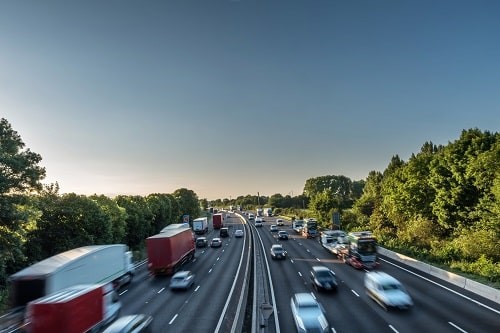Everyone in a business can play a vital role in minimising the risk from at-work driving, but this message will quickly become lost unless directors and managers are genuinely committed to improving road safety and always set a good example when it comes to driver safety.
Features
Staying safe on the road
Do you play the National Lottery? Millions do and, every week, they buy a ticket in the hope of winning the jackpot. Yet the odds of doing that are a vanishingly small one in 45 million! And still millions of people think it might be them.
In Great Britain, there are roughly 20 million vehicles driven on business. This is made up of just over 700,000 company cars, over four-and-a-half million vans, over 600,000 HGVs and a staggering 14 million private cars thought to be used for work journeys – some every day, some only occasionally.
Every year, according to government statistics, around 40,000 people are injured in collisions that involve someone who was driving for work. These are only the injuries that are reported – many aren’t. And there are many more that only involve damage to vehicles or property. This means the odds of being involved in an injury collision while driving for work are just one in 500 and yet very few people ever believe it will happen to them.
 While poor driving can obviously put your drivers and other road users at risk, it can also cost your organisation huge amounts of money. Photograph: iStock
While poor driving can obviously put your drivers and other road users at risk, it can also cost your organisation huge amounts of money. Photograph: iStock
That means if your organisation has a fleet of 500 vehicles you can expect your drivers to be involved in at least one injury collision every year on average. If your drivers and vehicles aren’t managed well, the odds could be even higher.
On top of this, the Parliamentary Advisory Council for Transport Safety (PACTS) conducted a review of the government crash statistics to find out which mode of transport posed the biggest risk to other road users. It found vans and light goods vehicles were involved in more than twice as many fatalities as motorcycles or HGVs and eight times as many as those involving cars.
Anyone who manages vans and drivers has a legal duty of care under the Health and Safety at Work Act 1974 to take all ‘reasonably practicable’ steps to minimise the risk to staff, and anyone else who may be affected by the company’s operations.
In short, this legislation means that:
- The company mustn’t do anything that puts its drivers at risk
- The company’s work-related driving activities mustn’t endanger any other road users
- Directors must put appropriate policies and procedures in place to ensure that this is so
- And all employees, including drivers, managers and directors, must follow those policies and procedures at all times.
The key to success is understanding how these legal responsibilities are shared across the business at all levels:
- Directors and managers have a responsibility to ensure that risks are identified and managed, and that the correct policies and procedures are put in place
- The company’s drivers have a responsibility to follow those procedures and behave responsibly at all times, driving safely and following the Highway Code
- Line managers, work schedulers and others may also have an important role to play in managing the risk, by ensuring that drivers aren’t subject to unreasonable demands that might encourage them to speed or increase the risk of fatigue.
How do we get there? By going round in circles!
It’s not always obvious where to start with managing driver risk. After all, there are so many different areas that need to be tackled. And how does a business we know whether what they’re doing is good or bad, or whether they have any glaring gaps? It’s easy to feel like you’re just going round in circles.
 Simon Turner: Leaders have to ensure their commitment is genuine or it will all fall down very quickly.
Simon Turner: Leaders have to ensure their commitment is genuine or it will all fall down very quickly.
Driving for Better Business, a government-backed National Highways programme to help employers in both the private and public sectors reduce work-related road risk, has created a range of free online tools that can help.
- Benchmarking – allows organisations to see how they fare when key metrics are set against the performance of their peers, and it becomes clear how they stack up against both a user average benchmark and also a good practice benchmark
- Gap analysis – step two involves a deep dive into an organisation’s current policies and processes to highlight the areas that could deliver the required improvements to raise the organisation’s benchmarking scores
- Action – how can a business implement those new processes effectively? The resources on the Driving for Better Business website include tools, guides, advice and examples of good practice.
So, while you’ll still be going round in circles at least they’ll be productive circles, and you’ll be doing it with the expectation that you and your fleet will be performing a little bit better each time around.
Is this really how we do things round here? Culture must come from the top.
Culture is a hugely important part of this process and is vital to improving driver safety. Culture can be defined as ‘the way we do things round here’. When new people start working for an organisation, they’ll look around them at how things are done and copy the prevailing behaviours. If they see corners being cut, they’ll cut corners themselves and, if they see everyone taking care to do things right, then they copy them to fit in.
The lowest standards that an employer, director, manager or supervisor displays are the highest standards they can expect from the people they manage. The same applies to contractors: a business, employer or manager can’t expect a high standard if they don’t exhibit that themselves.
This is why it’s so important to manage your drivers well, ensuring they are clear about the standards expected of them. It means the business needs to focus on three things: a good driving for work policy; the policy must be clearly communicated to all staff; and it should be consistently applied and monitored.
These are the key building blocks of a strong and resilient safety culture. Good drivers are your brand ambassadors, and they play a vital role in the successful integration of safe new drivers.
Just the cost of doing business?
Running vans can be an expensive business. While poor driving can obviously put your drivers and other road users at risk, it can also cost your organisation huge amounts of money, but often in ways you may not realise.
The most obvious costs are fleet insurance premiums and repairs arising from unnecessary vehicle damage, whether that be serious collisions or just avoidable parking scrapes. However, there are many hidden costs that are also involved such as the increase in admin and management time sorting out claims and repairs, right up to staff absence and vehicle off-road time if the incident was more serious.
Operational costs such as fuel, tyres, routine service and maintenance, insurance and damage repairs are often simply seen as the cost of doing business, yet they can be significantly higher than they need to be when drivers and vehicles aren’t being managed properly.
However, you can only control costs if you are measuring and monitoring the right data and linking it to driver behaviour. If you aren’t measuring and you aren’t monitoring then you aren’t managing – it’s as simple as that!
Stand up and be counted
It is vitally important that the leaders in charge of the business clearly commit to supporting those responsible for managing driver risk and that they can put into words why driver safety is so important to them personally and to the business as a whole. Leaders have to ensure their commitment is genuine or it will all fall down very quickly.
A leader who states how important driver safety is, and then fails to take an interest or provide support when needed or, worse, actively goes against the policy such as failing to abide by a mobile phone policy or failing to pull up employees who don’t meet the standards, will quickly lose the support of the workforce and the culture will fail.
So don’t allow your driver risk management to become a lottery. Knowledge and careful planning are needed to ensure that you, your drivers, other road users and your business are fully protected, and the free Driving for Better Business programme can help.
If you’d like to learn more about what you and your organisation should be doing and whether you have any gaps in your driver risk management, join our free programme. We have a wealth of free online tools and resources to help you understand where your priorities should be to reduce risk, control costs and improve efficiency.
For more information go to: drivingforbetterbusiness.com
Simon Turner is Campaign manager at Driving for Better Business
For case studies from Driving for Better Business read this piece on how excellent management of occupational road risk pays dividends: here
FEATURES

Sedentary working and how to combat the ‘sitting disease’
By Gavin Bradley, Active Working on 05 April 2024
Prolonged and excessive sitting poses a major risk to our health, but the Get Britain Standing campaign and On Your Feet Britain Day on 25 April are a great way of encouraging workers to sit less and move more.

Company culture and wellbeing: a crucial link
By Bex Moorhouse, Invigorate Spaces on 05 April 2024
Investing in measures to support worker wellbeing will be ineffective unless the company culture genuinely incorporates values like teamwork, involvement, flexibility and innovation.

Office design and culture: happier and healthier staff – or the opposite?
By Guy Osmond, Osmond Ergonomics on 03 April 2024
Applying ergonomic principles to workstation set-ups and ensuring the physical environment supports neurodivergent people are just some of the ways of creating an office where everyone can thrive, but a supportive and positive organisational culture is vital too.


